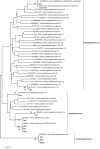Evidence for swine and human papillomavirus in pig slurry in Italy
- PMID: 31251456
- PMCID: PMC7166630
- DOI: 10.1111/jam.14363
Evidence for swine and human papillomavirus in pig slurry in Italy
Abstract
Aims: The diversity and the geographical distribution of swine papillomaviruses (PVs) are virtually unknown. The occurrence and the diversity of swine PV were therefore investigated in pig slurry collected in Italy, to contribute towards filling this gap in knowledge.
Methods and results: Twenty-two slurry samples underwent analysis by nested PCR and DNA sequencing using published and newly designed specific primer pairs for Sus scrofa papillomavirus (SsPV) type 1 and 2 (SsPV1 and 2), along with degenerate PV-specific primers targeting the major coat protein L1 and the helicase protein E1. Overall, three samples (13·6%) were positive for SsPV1 by specific primers, and nucleotide (nt) sequences showed 99-100% nt identity with SsPV1 variant a (EF395818), while SsPV2 was not found in any sample. Using generic primers, eight samples (36·4%) were tested positive for human papillomavirus (HPV), and were characterized as follows: β1-HPV8, β1-HPV14, β1-HPV206, β2-HPV113, β2-HPV120 and γ1-HPV173. Moreover, one unclassified γ-type was detected.
Conclusions: Both swine and human PVs were detected in pig slurry in this study. The unexpected presence of HPV in pig waste could be explained as the result of an improper use of the sewage collection pits and/or with improper procedures of the operators.
Significance and impact of the study: This study reports the first detection of SsPV1 in Italy, along with the first detection of HPVs in pig slurry samples in Italy, and expands our knowledge about PV diversity and geographic distribution.
Keywords: diversity; environmental; identification; viruses; waste.
© 2019 The Society for Applied Microbiology.
Conflict of interest statement
The authors declare that there are no conflict of interest.
Figures
References
-
- Arroyo, L.S. , Smelov, V. , Bzhalava, D. , Eklund, C. , Hultin, E. and Dillner, J. (2013) Next generation sequencing for human papillomavirus genotyping. J Clin Virol 58, 437–442. - PubMed
-
- Auffret, M.D. , Brassard, J. , Jones, T.H. , Gagnon, N. , Gagné, M.‐J. , Muehlhauser, V. , Masse, L. , Topp, E. et al. (2019) Impact of seasonal temperature transition, alkalinity and other abiotic factors on the persistence of viruses in swine and dairy manures. Sci Total Environ 659, 640–648. 10.1016/j.scitotenv.2018.12.306. - DOI - PubMed
-
- Berkhout, R.J. , Tieben, L.M. , Smits, H.L. , Bavinck, J.N. , Vermeer, B.J. and ter Schegget, J. (1995) Nested PCR approach for detection and typing of epidermodysplasia verruciformis‐associated human papillomavirus types in cutaneous cancers from renal transplant recipients. J Clin Microbiol 33, 690–695. - PMC - PubMed
MeSH terms
Substances
Associated data
- Actions
- Actions
- Actions
- Actions
- Actions
- Actions
- Actions
- Actions
- Actions
- Actions
- Actions
LinkOut - more resources
Full Text Sources
Research Materials
Miscellaneous


